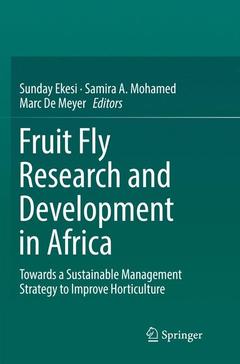Section A. Biology and Ecology
Chapter 1: Taxonomy and systematics of African fruit flies – M. De Meyer
Chapter 2. Identification tools for African frugivorous fruit flies (Diptera: Tephritidae) – M. Virgilio
Chapter 3: Population genetics of African frugivorous fruit flies (Diptera: Tephritidae): current knowledge and future perspectives – M. Virgilio and H. Delatte
Chapter 4: Role of microsatellite markers in molecular population genetics of fruit flies with emphasis on the Bactrocera dorsalis invasion of Africa – F. Khamis and A. Malacrida
Chapter 5: Fruit fly species composition, distribution and host plants with emphasis on mango-infesting species – I. Rwomushana and C. M. Tanga
Chapter 6: Fruit fly species composition, distribution and host plants with emphasis on vegetable-infesting species – C. M. Tanga and I. Rwomushana
Chapter 7: Exotic invasive fruit flies (Diptera: Tephritidae): in and out of Africa – M. De Meyer and S. Ekesi
Chapter 8: Feeding and mating behaviour of African fruit flies – A. Manrakhan
Chapter 9: Chemical ecology of African tephritid fruit flies – A. T. Fombong, D. Kachigamba and B. Torto
Chapter 10: Fruit fly nutrition, rearing and quality control – S. A. Mohamed, F. K. Khamis and C. M. Tanga
Chapter 11: The ontological modelling of fruit fly control and management knowledge - C. C. Kiptoo, A. Gerber and A. Van der Merwe
Section B. Pre-harvest and Post-harvest Management Measures
Chapter 12: Detection and monitoring of fruit flies in Africa – A. Manrakhan
Chapter 13: Baiting and male annihilation techniques for fruit fly suppression in African – S. Ekesi
Chapter 14: Waste brewer’s yeast as an alternative source of protein for use as a bait in the management of tephritid fruit flies – S. Ekesi and C. M. Tanga
Chapter 15: Development and application of mycoinsecticides for the management of fruit flies in Africa – N. K. Maniania and S. Ekesi
Chapter 16: In and out of Africa: Parasitoids used for biological control of fruit flies – S. A. Mohamed, M. M. Ramadan and S. Ekesi
Chapter 17: From behavioural studies to field application: improving biological control strategies by integrating laboratory results into field experiments – K. Merkel, V. Migani, S. Ekesi and T.S. Hoffmeister
Chapter 18: The use of weaver ants in the management of fruit flies in Africa - J.-F. Vayssières, J. Offenberg, A. Sinzogan, A. Adandonon, R. Wargui, F. Anato, H. Y. Houngbo, I. Ouagoussounon, L. Diamé, S. Quilici, J.-Y. Rey, G. Goergen, M. De Meyer and P. Van Mele.
Chapter 19: Sterile Insect Technique (SIT) for fruit fly control – The South African experience – B. N. Barnes
Chapter 20: Cold and heat treatment technologies for post-harvest control of fruit flies in Africa
– T. G. Grout
Chapter 21: Photographs of some native and exotic fruit fly species in Africa and their parasitoids
Section C. Country Specific Action Programmes and Case Studies
Chapter 22: Integrated management of fruit flies – case studies from Uganda – B. E. Isabirye, C.K. Nankinga, A. Mayamba, A. M. Akol, I. Rwomushana
Chapter 23: Integrated management of fruit flies – case studies from Tanzania – M. Mwatawala
Chapter 24: Integrated management of fruit flies – case studies from Mozambique – D. R. Cugala, M. De Meyer and L. J. Canhanga
Chapter 25: Integrated management of fruit flies – case studies from Nigeria – V. Umeh and D. Onukwu
Chapter 26: Release, establishment and spread of the natural enemy Fopius arisanus (Hymenoptera: Braconidae) for control of the invasive oriental fruit fly Bactrocera dorsalis (Diptera: Tephritidae) in Benin, West Africa - D. Gnanvossou, R. Hanna, A. H. Bokonon-Ganta, S. Ekesi and S. A. Mohamed
Chapter 27: Integrated management of fruit flies – case studies from Ghana – M. K. Billah and D. D. Wilson
Chapter 28: Integrated management of fruit flies – case studies from the Indian Ocean Islands – P. Sookar and J.-P. Deguine
Section D. Experiences from actions programmes outside Africa
Chapter 29: Area-wide management of fruit flies (Diptera: Tephritidae) in Hawaii - R. I. Vargas, J. C. Piñero, L. Leblanc, N. C. Manoukis and R. F. L. Mau
Chapter 30: Management of fruit flies in Mexico – P. Liedo
Chapter 31: Overview of the programme to eradicate Bactrocera carambolae in South America – D. Midgarden, A. van Sauers-Muller, M. J. Signoretti Godoy and J-F Vayssières
Chapter 32: Systems approaches for managing the phytosanitary risk of trading in commodities that are hosts of fruit flies – E. B. Jang
Section E. Socioeconomic Impact Assessment
Chapter 33: Economic impact of integrated pest management strategies for the suppression of mango-infesting fruit fly species in Africa - B. W. Muriithi, G. Diiro, H. Affognon and S. Ekesi
Section F. Lessons Learnt and Future Perspectives
Chapter 34: Lessons learnt and future perspectives – S. Ekesi, S. A. Mohamed and M. De Meyer




